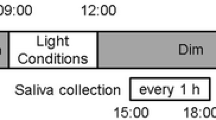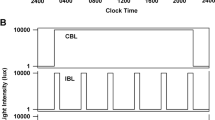Summary
The present study investigated the effect of dim white light on nocturnal plasma melatonin in males and females. Subjects were exposed to light between 2400hr and 0100hr. No significant gender differences were found with both 200lux (p > 0.1) and 500lux (p > 0.1) of light. Furthermore the amplitude of the melatonin rhythm was not significantly different with gender. This suggests that at low intensities the melatonin sensitivity to light is not differentially regulated between sexes.
Similar content being viewed by others
References
Bojkowski CJ, Arendt J (1990) Factors influencing urinary 6-sulphametoxymelatonin, a major melatonin metabolite, in normal human subjects. Clin Endocrinol 33: 435–444
Boyce P, Kennaway DJ (1987) Effects of light on melatonin production. Biol Psychiatry 22: 473–478
Cassone VM, Warren WS, Brooks DS, Lu J (1993) Melatonin, the pineal gland, and circadian rhythms. J Biol Rhythms 8 [Suppl]: S73-S81
Hariharasubramanian N, Nair NPV, Pilapil C (1984) Circadian rhythm of plasma melatonin and cortisol during the menstrual cycle. In: Brown GM, Wainwright SD (eds) The pineal gland. Oxford Pergamon, London, p 31
Laakso ML, Porkka-Heiskanen T, Stenberg D, Alila A (1991) Interindividual differences in the responses of serum and salivary melatonin to light. In: Fraschini F, Reiter RJ (eds) Role of melatonin and pineal peptides in neuroimmunomodulation. Plenum Press, New York, pp 307–311
Lewy AJ, Sack RL (1986) Biological rhythms and behaviour in humans: the effects of light. In: Dennerstein L, Fraser I (eds) Hormone and behaviour. Elsevier Science Publications B.V., New York, p 1
Lewy AJ, Wehr TA, Goodwin FA, Newsome DA, Rosenthal NE (1981) Manic-depressive patients may be supersensitive to light. Lancet i: 383–384
Lynch HJ, Brzezinski A, Deng HH, Lieberman HR, Wurtman RJ (1987) Effects of behavioural and physiological variables on melatonin secretion in humans. In: Reiter RJ, Fraschini F (eds) Advances in pineal research, 2. John Libbey, London, pp 181–193
McIntyre IM, Norman TR, Burrows GD, Armstrong SM (1989a) Human melatonin suppression by light is intensity dependent. J Pineal Res 6: 149–156
McIntyre IM, Norman TR, Burrows GD, Armstrong SM (1989b) Quantal melatonin suppression by exposure to low intensity light in man. Life Sci 45: 327–332
McIntyre IM, Norman TR, Burrows GD, Armstrong SM (1989c) Human melatonin response to light at different times of the night. Psychoneuroendocrinol 14(3): 187–193
McIntyre IM, Norman TR, Burrows GD, Armstrong SM (1992) Melatonin, cortisol and prolactin response to acute nocturnal light exposure in healthy volunteers. Psychoneuroendocrinol 17(2/3): 243–348
Monteleone P, Esposito G, La Rocca A, Maj M (1995) Does bright light suppress nocturnal melatonin secretion more in women than men. J Neural Transm 102: 75–80
Moore RY, Klein DC (1974) Visual pathways and the central neural control of a circadian rhythm in pineal serotonin N-acetyl transferase activity. Brain Res 71: 17–24
Seggie J, Tainsh S (1989) Age and sensitivity to light: implications for depression, sundowning and lighting standards. Aging and health: linking research and public policy. Lewis Publishers Inc, Michigan
SPSS (1986) SPSSx users manual. McGraw-Hill Book Company & SPSS Inc, Chicago, pp 863
Author information
Authors and Affiliations
Rights and permissions
About this article
Cite this article
Nathan, P.J., Burrows, G.D. & Norman, T.R. The effect of dim light on suppression of nocturnal melatonin in healthy women and men. J. Neural Transmission 104, 643–648 (1997). https://doi.org/10.1007/BF01291882
Received:
Accepted:
Issue Date:
DOI: https://doi.org/10.1007/BF01291882




